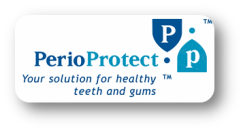
Periodontal Therapy
Diagnosis
Periodontal disease is diagnosed by your dentist or dental hygienist during a periodontal examination. This type of exam should always be part of your regular dental check-up.
A periodontal probe is gently used to measure the pocket or space between the tooth and the gums. The depth of a healthy sulcus measures 1-3mm and does not bleed. The periodontal probe helps indicate if pockets are deeper than 3mm. As periodontal disease progresses, the pockets usually get deeper.
You hygienist or dentist will use pocket depths, amount of bleeding, inflammation, tooth mobility, etc, to make a diagnosis that will fall into a category below:
Gingivitis
Gingivitis is the first stage of periodontal disease. Plaque and its toxin by-products irriate the gums and cause them to swell, be tender and bleed.
Periodontitis
Plaque that isn’t removed from the tooth will harden to a rock like substance called tartar or calculus. As this tartar grows it will invade the areas in between the teeth or below the gumline and release a toxin that destroys the gum’s attachment to the tooth and the bone around the tooth. Pockets greater than 3mm are present. Also some recession may be present, along with inflammation and bleeding. This infection in the gums is usually painless.
Advanced periodontitis
As the bacteria and toxins inhabit the area below the gum they continue to grow and multiple creating deeper pockets, 6mm or more, and advanced bone loss. There is often an odor associated with this disease, along with inflammation, bleeding and recession.
Treatment of Periodontal Disease
Periodontal treatment methods depend upon the type and severity of the disease. Your dentist and dental hygienist will evaluate for periodontal disease and recommend the appropriate treatment.
Periodontal disease progresses as the pocket between the tooth and the gums gets filled with bacteria, plaque, and tartar, causing irritation to the surrounding tissues. When these irritants remain in the pocket space, they can cause damage to the gums and bone that supports the teeth.
If the disease has progressed to more advanced stages, a special periodontal cleaning called scaling and root planing or deep cleaning is indicated. It is usually done one or two quadrants of the mouth at a time while the gums are numb. In this procedure tartar, plaque and toxins are removed from above and below the gumline, and rough spots on the roots are made smooth so that the gum tissue will reattach to the root and cause the pockets to decrease. There are also special medicines that can be placed under the gum to prevent the bacteria from recolonizing the area. There are special tools that may be recommended to help keep the teeth clean after the root planing.
If the pockets do not heal after scaling and root planning, periodontal surgery may be required to reduce the pocket depths, making the teeth easier to keep clean in the future.
Periodontal Maintenance
It takes only twenty four hours for plaque that is not removed from your teeth to turn into tartar or calculus. Daily homecare helps control plaque and tartar formation, but those hard to reach areas will also need special attention.
Once your periodontal therapy has been completed, your dentist and hygienist will recommend that you have regular maintenance cleanings up to four times a year. At these cleaning appointments the pocket depths will be carefully checked to ensure that they are healthy. Plaque and calculus that is difficult for you to remove on a daily basis will be removed from above and below the gumline.
In addition to you periodontal cleaning and evaluation, your appointment will usually include:
- Examination of diagnostic x-rays - essential for detection of decay, tumors, cysts, and bone loss. Also x-rays help determine tooth and root positions.
- Examination of existing restorations - check current fillings and crowns
- Examination of tooth decay - check all surfaces for decay
- Oral cancer screening - check the face, lips, tongue, throat, cheeks, and gums for oral cancer
- Oral hygiene recommendations - review and recommend oral hygiene aids as needed.
- Teeth polishing - remove stain and plaque that is otherwise not removed during tooth brushing and scaling
Good oral hygiene practices and periodontal cleanings are essential in maintaining dental health and keeping periodontal disease under control.
Perio Protect
Perio Protect® is a comprehensive treatment approach that combines professional cleanings with a special, comfortable tray delivery of medication that you use at home between office visits. The Perio Tray® by Perio Protect is similar to a mouth-guard, but it has a special sealing system to deliver medication below the gums. You put medication in the tray and wear it for a few minutes a day. It is that easy.
The most important advantage of the Perio Protect approach is that it can treat the bacteria causing the disease in a comfortable way, minimizing surgery and antibiotics.
The Perio Tray is important because bacteria reproduce so quickly under the gums that it is difficult to control them between office visits. Research shows that when professional cleanings are combined with Perio Tray delivery of hydrogen peroxide gel, patients get better results than the cleanings alone.
Your actual treatment plan is determined by your Perio Protect dentist evaluating your specific condition.
Perio Protect® has been a leader in minimally invasive dentistry, as a periodontal (gum) disease treatment, for more than ten years with a method that offers patients a gentle, yet effective way to fight the bacteria that cause gum disease.



